Railroad Glossary: Terms, Definitions, Meanings
Last revised: August 23, 2024
By: Adam Burns
Included here is information pertaining to railroad terms and meanings, a glossary if you will. On this page is a general listing while more specific topics are covered in the links below including steam locomotives, infrastructure, rolling stock, motive power, and organizations.
In addition, there are individual articles highlighting particular subjects such as articulation, water tanks, tell-tales, ditch lights, air brakes, and much more.
To read more about these simply find the appropriate link. The railroad industry has amassed an interesting and often times confusing laundry list of meanings/slang that can trip up even seasoned rail enthusiasts. Interestingly, some terms hearken back to equipment no longer used.
For instance, "high ball" was an early type of signaling system employed across the country. When the ball was raised high the engineer knew he was clear to proceed.
The term remained in use throughout the 20th century by crewmen for this purpose, long after the system had been retired by most railroads. My hope is to be of, at least, some help in shedding light on many terms.
Photos
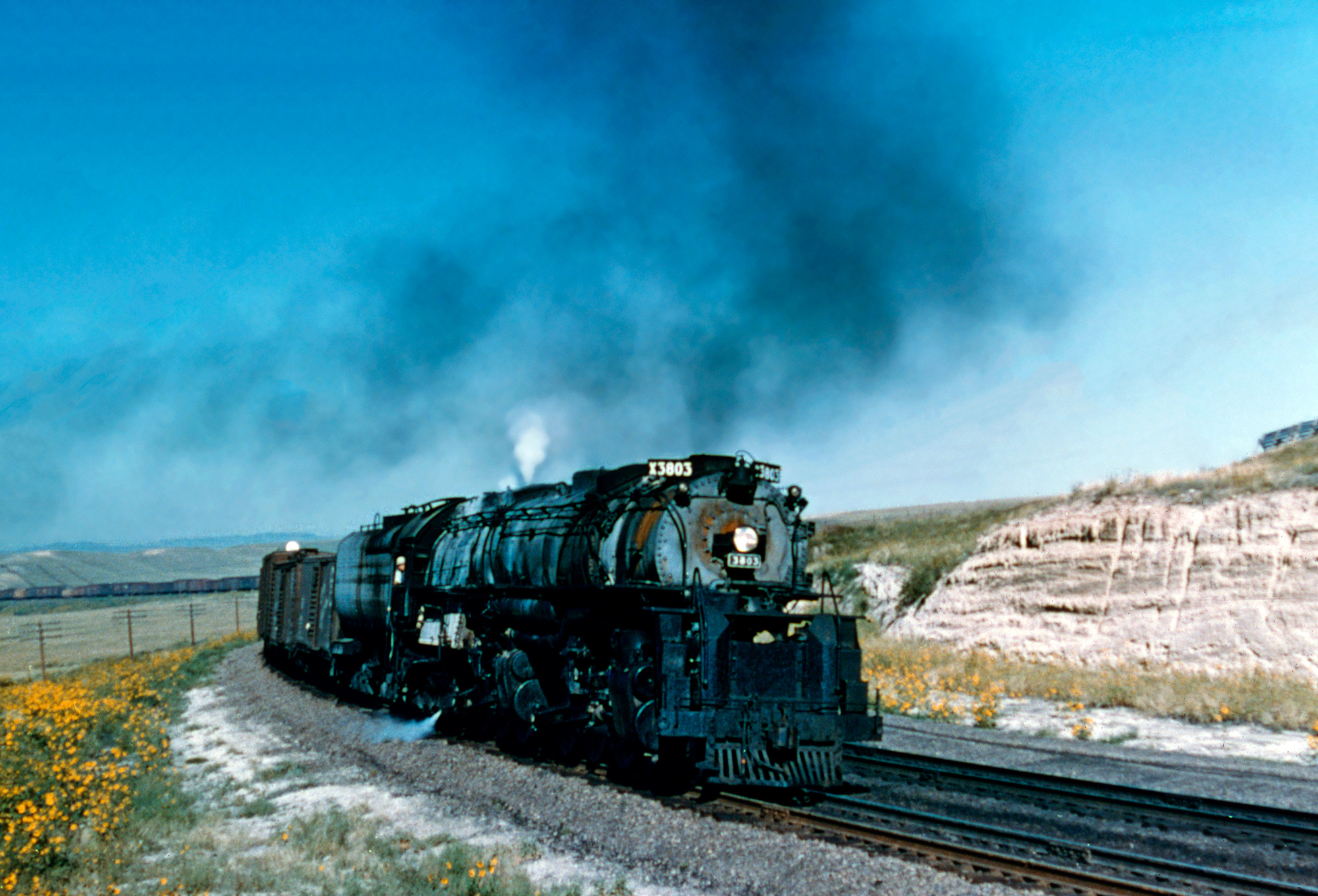 Union Pacific 4-6-6-4 #3803 climbs Archer Hill, just east of Cheyenne, Wyoming on August 31, 1955. J.E. Shaw photo. American-Rails.com collection.
Union Pacific 4-6-6-4 #3803 climbs Archer Hill, just east of Cheyenne, Wyoming on August 31, 1955. J.E. Shaw photo. American-Rails.com collection.Overview
American railroads have now been in continuous operation for nearly two centuries. It should come as a no surprise that during that time a entire dictionary of words have resulted, describing everything from locomotives and rolling stock to tools and infrastructure.
There is now even a book highlighting this very subject, Glen Landin's "The Illustrated Railroad Glossary: 101 Common Railroad Terms." Over time, as technologies changed, new terms appeared while others vanished.
For instance, while tell-tales are no longer in use (devices place along the right-of-way, usually made of light chain or rope, to warn brakeman working the rooftops that an impending obstacle was ahead) the FRED (Flashing Rear End Device) gained acceptance during the 1980s as a replacement to the venerable caboose.
Despite this car's redundancy it remains beloved as have many devices since retired. Today there are hundreds and hundreds describing every aspect of railroads from railroad ties to knuckle-couplers (something found almost exclusively in North America).
Definitions, Terms, and Slang
AEI: Short for Automatic Equipment Identification it is meant as a tracking system for cars used by many railroads throughout the country (particularly Class Is). Located along right-of-ways it will scan any car that passes by which has a data tag placed on it.
Adhesion factor: This term essentially describes how well a locomotive can grip the rails, it is measured by the percent of total on a locomotive's driving wheels available for traction.
Affiliate: A company owned or controlled by another.
Availability: Refers to when a locomotive is free to be used in revenue service and down for some type of maintenance work.
Bad order: A freight car which has been barred from service because of a mechanical problem or defect. To mark such a car a card is placed on it by a car inspector.
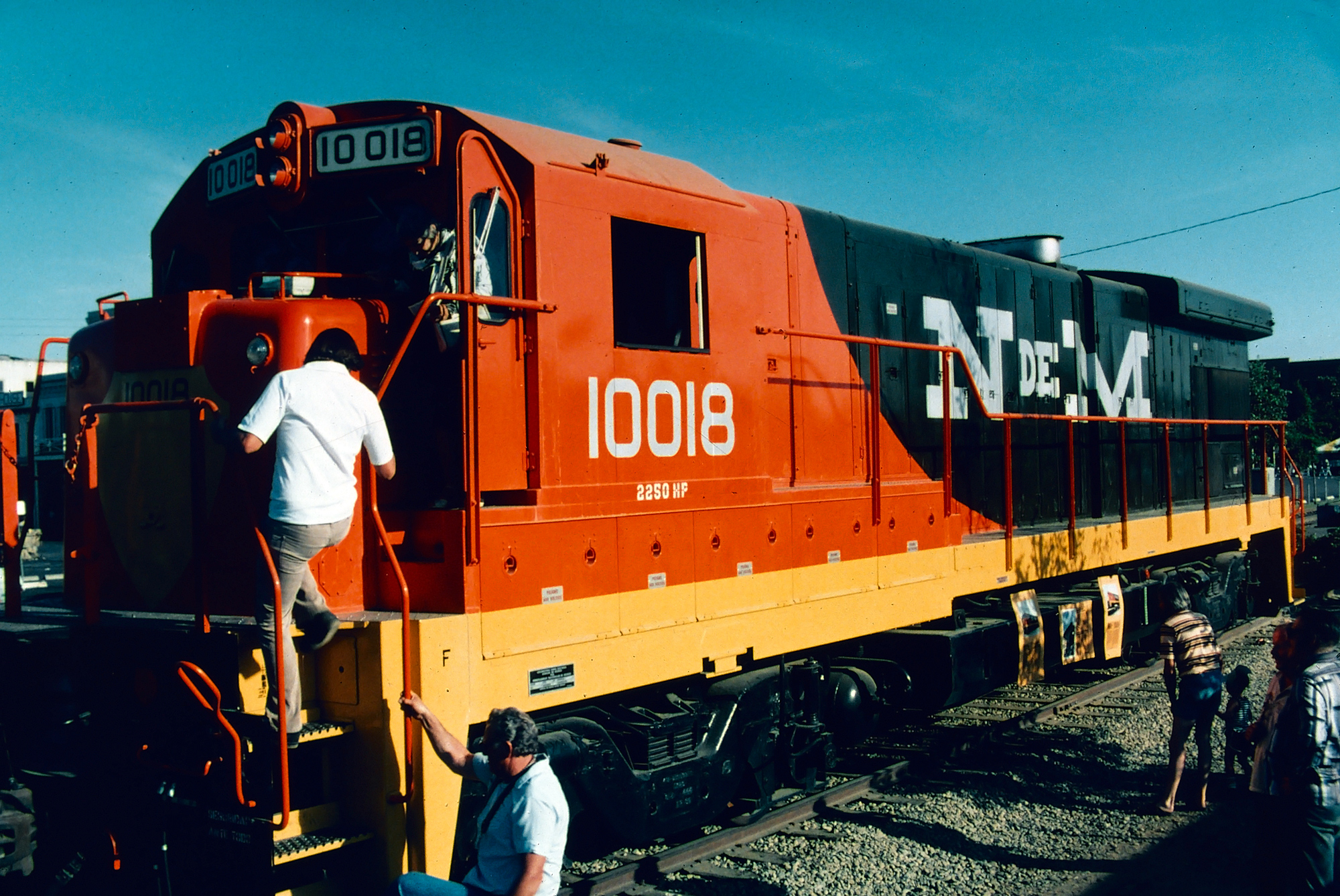 Ferrocarriles Nacionales de México (NdeM) B23-7 #10018 is on display at Railfair '81 in Sacramento, California during May of 1981. Fred Nicas photo. American-Rails.com collection.
Ferrocarriles Nacionales de México (NdeM) B23-7 #10018 is on display at Railfair '81 in Sacramento, California during May of 1981. Fred Nicas photo. American-Rails.com collection.Belt line: Refers to a railroad that operates exclusively in and/or around a large city.
BLE: Refers to the Brotherhood of Locomotive Engineers which is a railroad labor union (made up of engineers and dispatchers throughout the U.S. and Canada) created in 1863.
Boomer: A railroader who changes jobs often as he drifts through the country.
Bridge route: Refers to a railroad which typically has more bridge/through traffic operating over its rails than terminating/originating traffic.
Bridge traffic: Also known as overhead traffic it is freight received from one railroad to be moved by a second railroad for delivery to a third.
Bulk: Commodities such as grain, coal, soda ash, ore, plastic pellets, liquid sweeteners, petroleum, etc.
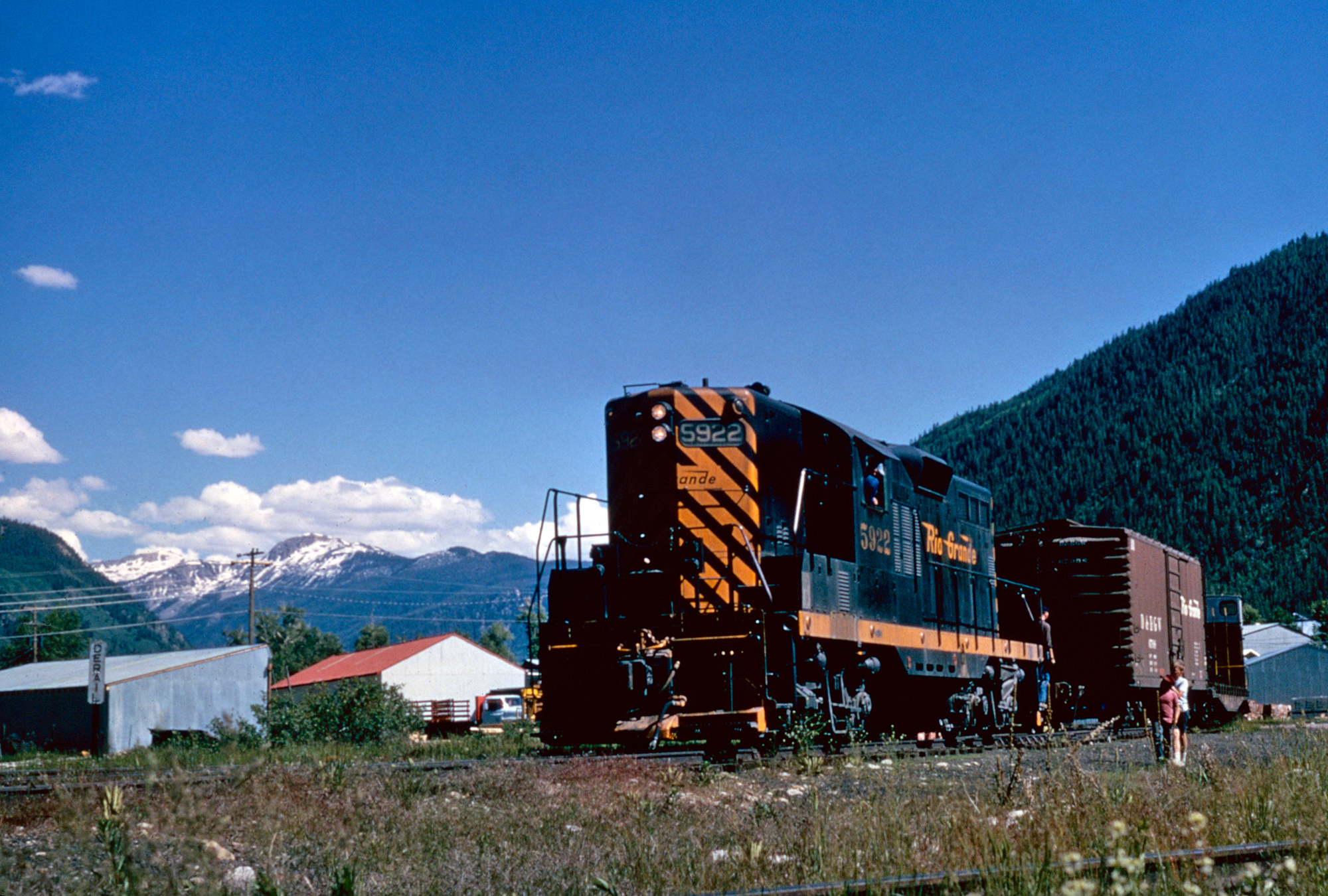 Rio Grande GP9 #5922 switches customers in Aspen, Colorado at the end of the Aspen Branch during the 1970s. American-Rails.com collection.
Rio Grande GP9 #5922 switches customers in Aspen, Colorado at the end of the Aspen Branch during the 1970s. American-Rails.com collection.Bulletin order: This term describes notifications (typically on paper) given to railroad employees informing them of a train movement or operational change.
Charter: Necessary in creating a corporation, a governmental means (usually either state or country) of granting rights, franchises, and privileges to such.
Clearance diagram: A diagram the car and locomotive type and size a particular rail line (or any given section of track) can handle.
Clearance form: These forms were issued to passing trains by a lineside operator (usually at an interlocking tower) telling them, sequentially, their orders, if any.
COFC: Short for Containers On Flatcar, used to describe a type of train movement which hauls shipping containers.
Cog railroad: Cog railroads are capable of traversing incredible grades and to do so they use toothed wheels (similar to gearing) running between the rails to achieve this.
Common carrier: A company which offers services to the general public and anyone willing to use the company to move their goods for compensation in return. The Baltimore & Ohio was our nation's first common carrier.
Commuter service: Passenger train service that typically operates during normal working hours throughout the week hauling mostly workers to and from the workplace.
Company-owned railroad: A railroad's stock controlled by a company and not individuals.
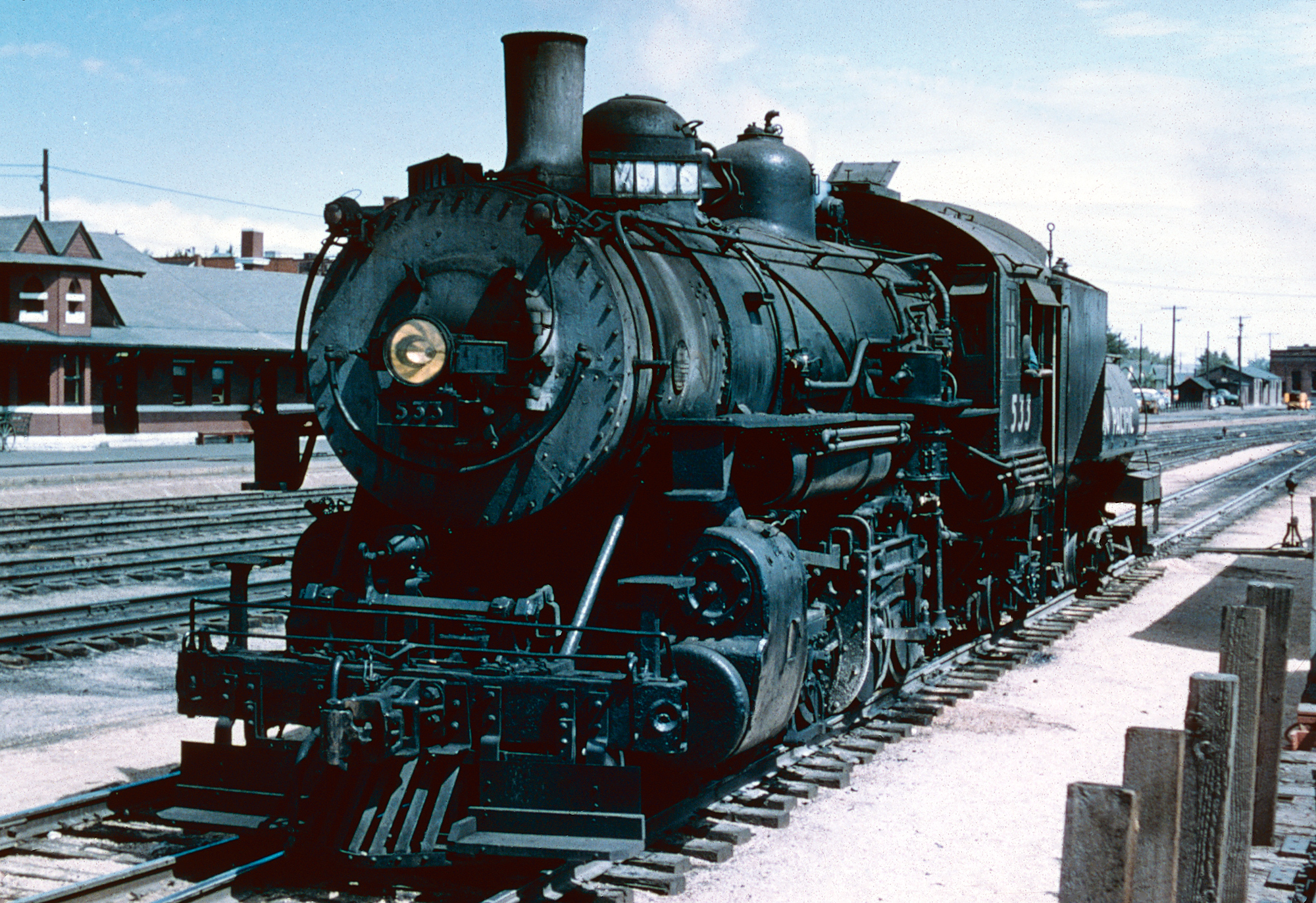 Union Pacific 2-8-0 #533 was photographed here at Rawlins, Wyoming on September 4, 1956. The locomotive was a C-57 class Consolidation, manufactured by UP shop forces in 1918 for subsidiary Oregon Short Line. J.E Shaw photo. American-Rails.com collection.
Union Pacific 2-8-0 #533 was photographed here at Rawlins, Wyoming on September 4, 1956. The locomotive was a C-57 class Consolidation, manufactured by UP shop forces in 1918 for subsidiary Oregon Short Line. J.E Shaw photo. American-Rails.com collection.Conductor: The crew member who is entirely responsible for the
train including its crew, cargo, and assures to it arrives to its
destination on time and safely.
Consignee: One who receives a freight shipment.
Consist: Used to describe the makeup of a train (i.e., freight, car types, etc.).
Consolidation: The merging of two corporations into an entirely new corporation.
Container: Standardized 40-foot box designed for shipping freight by rail, truck, or ship.
Controlling interest: Owning enough stock in a corporation to control that corporation.
CP: Abbreviation for control point on a railroad.
Crossbuck: The "X"-shaped sign found just before a road crosses railroad tracks. A passive crossbuck is just the sign itself: a white "X" with black lettering. An active crossbuck includes either flashing lights and/or gates that lower when a train approaches.
Cut: The term which describes a grouping of cars coupled together. It also refers to graded right-of-way that was achieved by digging through a hillside or mountain (without it actually being tunneled).
Deadhead: A term which applies to both railroad equipment and employees, meaning to move in a train but in no way helping, merely to ride along to be repositioned for later work/use.
Degree: Measures the angle of a curved segment of track. sharpness.
Departure yard: Like a staging track to ready locomotives, departure yards assemble cuts of cars to ready them for an outbound train.
Derail: Meaning to leave the rails. Also, a safety device placed on the track, usually on a siding or industrial spur, that guides a car, rolling away, off of the rails to prevent it from traveling onto the nearby main line and thus cause an accident.
Derating: Any means of changing the locomotive's prime mover (diesel engine) to improve fuel efficiency or lower maintenance costs.
Double the hill: Meaning to move a train over a hill or steep grade in two parts as the locomotives are simply not powerful enough to move it as one unit.
Doubleheading: Using two locomotives, independently, to move a train, usually over a steep grade. This was a common practice in the days of steam.
Double-stack: Meaning to stack one container on top of another in a special well car. This is much more efficient and profitable than, obviously, only hauling one container per car.
Drag: Slang for a slow freight.
Drawbar force: Somewhat refers to the "net" tractive effort involved by taking the total tractive effort and subtracting it from the tractive effort needed to move the locomotive.
Drayage: Meaning moving via truck.
Dual-mode: A locomotive which can operate conventionally as a locomotive or as an electric via shoes able to pick up the electrical current in the available third rail (thus, it can only operate in electric mode if the track includes a third rail).
Dual-service: Locomotives which pull both freight and passenger trains.
Dump the air: Meaning to apply the air brakes, usually during an emergency of some sort.
Eighth notch: Like the gears in an automobile the eight notch is the final, and most powerful position on the locomotive's throttle.
Embargo: Usually refers to when a railroad company (although a regulatory agency, like the FRA, is also capable of doing this) temporarily shuts down a rail line to all forms of train movements for some kind of outstanding reason.
Engineer: Person responsible for the operation of the locomotive. Other names the engineer is known by include hog head, hogger and hostler.
Extra board: The group of employees not assigned to normal runs.
First trick: Refers to the day's first work shift between 8 a.m. and 4 p.m.
Flimsies: Refers to the thin piece of paper train orders were once written on.
Form D: A track warrant used only be railroads in the eastern US and governed by operating rules set forth by the Northeast Operating Rules Advisory Committee (NORAC).
Full service trackage rights: Trackage rights agreement whereby the tenant railroad can serve all customers located along the owning railroad's segment of line it has rights to operate over.
Fusee: A flare used by railroads.
Gandy Dancer: This was once slang for one who maintained the railroad track and right-of-way. Its origins are difficult to trace but is said to be derived from the Gandy Manufacturing Company of Chicago, which manufactured track maintenance tools.
Golden State Route: Refers to Union Pacific's Kansas City, Kansas to El Paso, Texas main line, which used to be operated in conjunction with the Rock Island and Southern Pacific.
Granger roads: The term applied to the Midwestern/Plains railroads that earned a substantial portion of the earnings from America's Breadbasket (agriculture). These railroads included the Chicago & North Western, Chicago Great Western, Minneapolis & St. Louis, Rock Island, Milwaukee Road, and the Burlington Route.
Gross ton-mile: The total weight of cars and their lading when moving over a distance of one mile.
Haulage: This term describes a railroad's traffic hauled by another railroad between two points. The hauling railroad derives no earnings or profits from the movement.
Haulage rights: In this setup a railroad arranges to haul freight for a customer on another railroad's line, if a contract can be negotiated. The railroad which owns the line is responsible for all of particulars involved in moving the freight (switching, crews, locomotives, etc.) but receives none of the revenue and earnings.
Highball: The signal to operate the train at full speed. First used prior to common lighted, colored, signals when old-time ball signals were raised high to show a "clear" signal.
High-rail vehicle: Usually a standard pickup or utility truck with flanged wheels mounted to the frame that can be extended to operate on the tracks.
Hogger: Slang for locomotive engineer.
Holding company: A company that controls other companies through ownership.
Hostler: An employee which operates locomotives only around enginehouses.
Hotshot: A high priority freight train that is usually never held up and nearly always given the main line.
Hours of service law: Also known as the hog law by employees, it is a federal law mandating employees (particularly train crewmen/women) can only be on duty 12-hours at a time (in an effort to prevent fatigue).
In the hole: Used by railroaders to describe when a train is in a siding, usually waiting for another to pass.
Incentive per diem: This was a setup created in the 1970s whereby the industry pushed railroads to buy new freight cars with the enticement of payments for doing so. Soon after new freight cars popped on railroads large and small, particularly shortlines. However, the recession of 1978 and subsequent deregulation of the trucking industry killed the idea.
Industrial railroad: Railroads owned exclusively by industries merely to move cars around and within their property.
Interchange: A junction point that allows two railroads to switch or transfer cars. Also meaning to actively switch/exchange cars between the two railroads.
Intermodal: Refers to moving freight using more than one type of transportation (i.e., truck, rail, ship, etc.). Regarding railroad operations it usually describes the movement of truck trailers (Trailer-On-Flatcar) or container (Containers-On-Flatcar) movements.
Interurban: A termed applied to electrically-powered commuter operations that used to be very common in most cities of at least 10-15,000 residents and almost always had street trackage somewhere through the city (interurbans usually used a fleet of single, powered, cars to transport passengers).
They died away after roughly 1950 but have since been revived of late with new light rail projects popping up in cities all over the country (which also either use a single powered, car, or a small trainset to move passengers within a city limits).
Joint operation: Refers to operating two railroads as one but retain each railroad's board of directors.
Knuckle: The free-moving part of a coupler that actually keeps cars and locomotives mated to one another.
Lading: Refers to the cargo or freight the railroad is hauling.
LCL: Short for less-than-carload freight traffic.
Lignite: Refers to low-quality coal.
Line-haul railroad: Today this term refers to all Class Is, regionals, and some shortlines. It is used to describe a railroad that operates through freight from one point to another and is distinguished from switching and terminal railroads.
Load limit: The maximum load that a rail line/bridge/freight or passenger car is capable of handling.
Loading gauge: Describes the specifications that freight and passenger cars must adhere to so that they can safely clear all lineside structures, tunnels, bridges, underpasses, other equipment (if the line includes more than one track) and so forth.
Manifest: The paperwork that identifies each and every type of lading each freight car is carrying within a train. It also describes a train that is carry lading which is not intermodal or "unit" (i.e., all the same) in nature.
Marker: See EOT device.
Mars light: Widely popular and well known with railfans this trademark name referred to an auxiliary headlight (several different versions were produced) whose beam revolved in a figure-8 motion.
Meet: Occurs when two trains pass one another on a single-tracked line where one train is in the siding awaiting the other to pass.
Merger: The assimilation of one or more corporations by another.
Mixed train: Refers to a train hauling both freight and passengers.
Name train: This refers to, usually, passenger trains during the days when the private railroads operated them. A named train was much more esteemed than a train with only a number. Some freight trains were also once named and the principal worked in the same manor, it was the (or one of the) premier train(s) and received priority over all other freight trains.
Net ton mile: The movement of one ton of freight per mile.
Nominal: Refers to the actual rating of locomotive even if mechanical troubles or problems may result in the locomotive producing less horsepower for a period of time.
On the ground: Used by employees to describe a derailed train.
Operating ratio: Used to determine operating expenses as a percentage of revenue (anything over 80 is a bit high and should be lowered).
Overhead trackage rights: Trackage rights agreement whereby the tenant railroad cannot serve any customers located along the owning railroad's segment of line and only has rights to operate over it.
Overhead traffic: Also known as bridge traffic, which is traffic delivered by Railroad A to Railroad B where then Railroad B delivers this traffic on to Railroad C.
Per diem: A Latin term that means per day, it is used by railroads to mean the daily rental fee a car owner charges one wishing to use its car(s).
Pickup: A general term meaning to add cars to a train.
Pooling agreement: When separate railroads split all of their collective earnings amongst each other, no matter how much more traffic one railroad may carried over another.
Powder River Basin: Known as PRB, for short, it is a vast area of southern Montana and eastern Wyoming that is extremely rich in low-sulfur coal
Power: Another term for locomotives.
Profile: This term illustrates graphically the layout of a rail line in terms of its grades.
Receivership: During bankruptcy proceedings a corporation that is being managed by a receiver.
Recrew: When a train receives a new crew, usually occurring when the current crew has completed their 12-hour, FRA mandated, workday.
Regional railroad: A term to describe Class II railroads, which are larger than Class IIIs (shortlines) but smaller than Class Is, in terms of overall earned revenues.
Reporting marks: Up to four letters which identify the owner/operator of the car. A reporting mark ending in the letter "X" denotes a car owner that is not a railroad.
Restricted speed: This term describes the operating speed an engineer must adhere to, which in this case means he or she must be able to stop within half the range of an approaching stop signal or track impediment (such as another train). In terms of actual speed the train must be traveling no faster than 20 mph.
Right of way: Refers to a railroad line including all of the track, property, and roadbed.
Roadmaster: One who is responsible for railroad track maintenance.
Road number: The digits used to identifying a locomotive.
Roadbed: It is the foundation layer of fill that supports the track structure (i.e., ballast, track, ties, etc.).
Roll-by: Inspecting a train as it passes.
Rolling stock: Usually refers to freight and passenger cars but also includes locomotives.
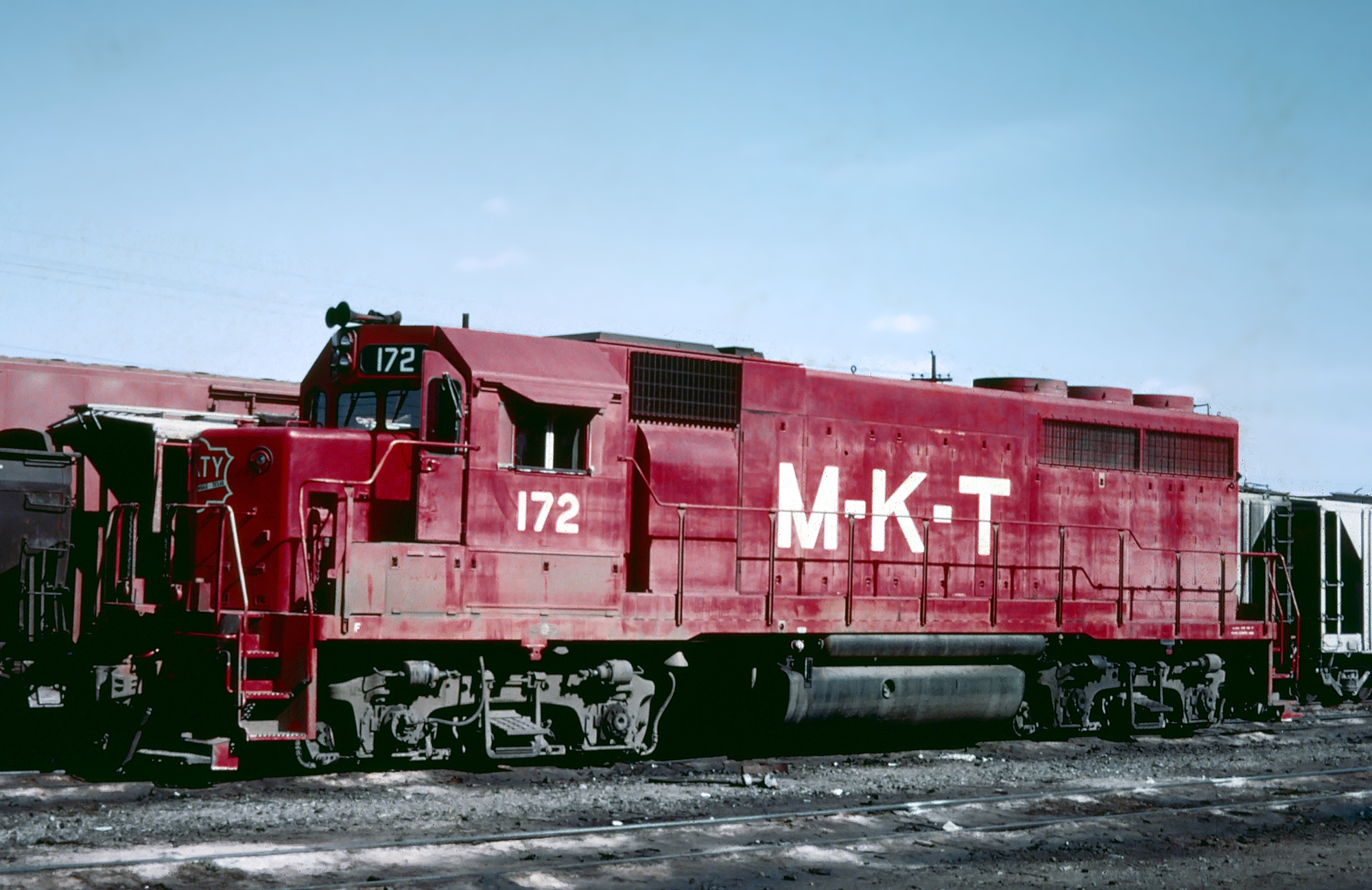 Missouri-Kansas-Texas ("Katy") GP40 #172 was photographed here at the road's terminal in Parsons, Kansas, circa 1969. American-Rails.com collection.
Missouri-Kansas-Texas ("Katy") GP40 #172 was photographed here at the road's terminal in Parsons, Kansas, circa 1969. American-Rails.com collection.Route mile: The actual physical, geographical, distance the railroad line travels not including extra tracks, yards, sidings, etc.
Ruling grade: The steepest section of railroad on any given rail line, it sets the amount of tonnage a train can handle.
Run 8: Also known as notch 8 or full power in diesel locomotives.
Runaround: Usually describes the maneuver of a locomotive uncoupling from a train, and attaching itself to the other end using a parallel railroad track (usually a siding). However, it also refers to a particular track that allows this to happen as well.
Run-through: A train that does not stop to do any type of switching or setting out/picking up of cars.
Section hand: A general track laborer assigned to a section gang.
Section house: Housing for a track maintainer provided by the employee's railroad.
Set out: Refers to when a train switches out a car, or group of cars, at a particular location, usually either a siding or industrial spur.
Shorthaul: Moving freight over a shorter distance than what is possible between two given points (i.e., instead of carrying freight all of the way from New York to Chicago, for example, shorthauling it to, say, Pittsburgh and then another railroad finishes carrying it on to Chicago).
Short-time rating: In regards to a locomotive's traction motors the maximum amperage allowed over a period of time without damaging them. It is higher than continuous rating since the duration is much shorter.
Single-line haul: Refers to a shipment over only one railroad.
SIT: Stands for storage in transit.
Slack action: The result of "give" in each coupled car in a train that can sometimes be quite violent when it is pulled free.
Spot a car: To switch a freight car into a particular location for loading/unloading.
Stabbing: Refers to a delayed train that is not expected.
Stack train: The slang term for a train made up entirely of containers stacked two-deep per car.
Staggers Act: This act was named after Rep. Harley O. Staggers of West Virginia. It was signed into law by President Jimmy Carter on October 14, 1980, which allowed enormous deregulation of the railroad industry. Some of the advantages included allowing railroads to enter into contracts with shippers to prices and services, both without ICC approval.
Subsidiary: A company that is completely controlled by another through ownership of over 50% of its common stock.
Superelevation: This term simply describes the degree of banking within a curved segment of track so as to help alleviate the centrifugal force of moving trains.
Switching district: Refers to an area where shippers have their choice of railroad (i.e., more than one) to move their goods.
Tariff: The railroading term for a bill of service, so to speak, it defines the rates and regulations for hauling passengers and freight.
Terminal: The term describing areas where railroads make up, assemble, and dispatch trains (such as a large yard).
Terminal railroad: Usually operate within large cities, like Chicago, they do not pick up and deliver goods themselves but rather receive all their freight set off by line-haul railroads.
Through freight: A train not designated to set off or pick up cars when in transit.
Tires: The rims of locomotive driving wheels.
TOFC: Stands for Trailer-On-Flatcar, it is the haulage of highway truck trailers.
Tonnage rating: This term describes the maximum load a locomotive can handle over a particular section of track, which is set by the locomotive's tractive effort rating and ruling grade of the line.
Ton-mile: The movement of one ton of freight a distance of one mile, a standard transportation industry measure.
Trackage rights: An arrangement in which one railroad negotiates the right to operate its trains over certain segments of track owned by another.
Tractive effort: Also known as tractive force this term describes the force in pounds a locomotive exerts to turn its driving wheels. To calculate tractive effort it is adhesion factor multiplied by the weight on the driving wheels.
Trailing truck: Used to describe a truck on steam locomotives that was located under the cab and helped to stabilize the ride.
Train line: Describes the air-brake line in a train when it is completely connected and continuous.
Transit: A term that refers to commuter rail operations, usually hauling passengers from urban to suburban settings and vice-versa for the means of getting to and from work.
Truck: The wheel-axle-frame assembly under each end of a car or locomotive.
UDE: Short for UnDesired Emergency, this acronym describes when the air pressure is released within the air-brake system that has not been authorized by the engineer, such as when a derailment occurs.
Unit train: A train carrying a single type of commodity, such as coal or grain.
Varnish: A slang term that originally referred to when old wood-built passenger cars received high-gloss coats of varnish. The term is still used today to describe passenger cars and equipment, particularly
Waybill: A document containing information about a specific freight shipment, such as the shipper, consignee, routing information, car initials and number, description and weight of the commodity being shipped, and billing information.
More Terms
Brotherhood of Locomotive Engineers and Trainmen (BLET)
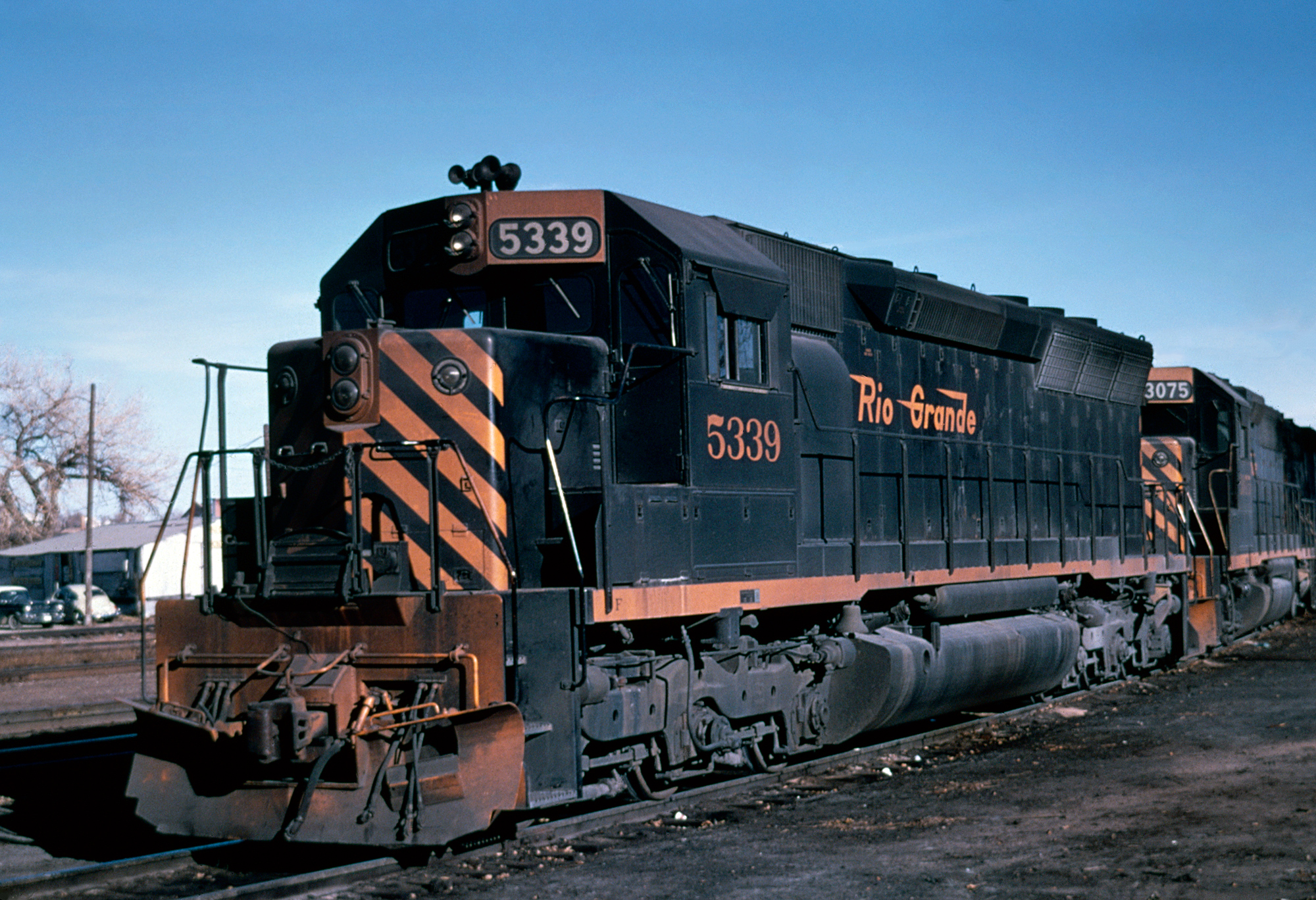 Rio Grande SD45 #5339 and GP40 #3075 in Pueblo, Colorado, circa 1969. American-Rails.com collection.
Rio Grande SD45 #5339 and GP40 #3075 in Pueblo, Colorado, circa 1969. American-Rails.com collection.Wayfreight: A term describing a local freight train often associated with the Burlington.
Wheel slip: Similar to any other type of wheel slip condition it is the result of a locomotive's driving wheels rotating faster than the train itself resulting in decreased pulling power. It usually occurs with a very heavy train from a stopped position or wet/slippery rails.
Work train: A train that does not earn revenue and usually used by railroads for maintenance-of-way work.
Zombie: A slang term describing the reuse of a locomotive's frame and trucks as the groundwork for a low-powered re-engined unit.
Recent Articles
-
Oregon Railroad Museums: A Complete Guide
Apr 25, 25 03:11 PM
With its rich tapestry of scenic landscapes and profound historical significance, Oregon possesses several railroad museums that offer insights into the state’s transportation heritage. -
North Carolina Railroad Museums: A Complete Guide
Apr 25, 25 02:56 PM
Today, several museums in North Caorlina preserve its illustrious past, offering visitors a glimpse into the world of railroads with artifacts, model trains, and historic locomotives. -
New Jersey Railroad Museums: A Complete Guide
Apr 25, 25 11:48 AM
New Jersey offers a fascinating glimpse into its railroad legacy through its well-preserved museums found throughout the state.

